Posted by Elena del Valle on May 6, 2013

A still image from the Es Fácil Ser Hombre ad campaign – click to enlarge
Video, photos: Formulatin
Beer maker Tecate wants to win over Spanish speaking and bilingual men 21 years of age and older in the United States and Mexico with Es Fácil Ser Hombre, its most recent Spanish language ad campaign. The company’s three 30-second TV spots, three 60-second radio spot and out-of-home ads will run across what its marketing executives consider its key Spanish language markets in the United States and Mexico.
The TV spots, filmed and produced in Mexico City, were completed in late 2012 and the radio spots in early 2013 by a team led by Felix Palau, vice president of Marketing for Tecate.
In the United States, the campaign will air in California, Texas, New Mexico, Arizona, and Illinois. Handled by MediaVest MV42, the media buy includes Univision, Telemundo, Unimas, Galavision, Estrella TV, Fox Deportes, ESPN Deportes, Univision Deportes, Azteca, LA TV and Nuvo TV. Scroll down to watch an ad from the campaign in Spanish.

A still image from the Es Fácil Ser Hombre ad campaign
“It’s important for us to ensure that our brand communication efforts in the U.S. and in Mexico are aligned. However, because we understand that there are nuances between Hispanic men living in both countries, we tested our Mexico-created spots in our key U.S. markets. We’re very happy with the positive feedback we received from consumers in these focus groups, and are certain that the inherent wit and humor in the spots is relevant to all Hispanic men con carácter,” said Palau by email.
The company launched the TV and radio spots April 22 and the OOH began rolling out April 29. The campaign is expected to run through the summer and into early fall. Company representatives declined to disclose the campaign budget or the number of staff involved in the project.
The campaign was created by Olabuenaga Chemistri, Tecate’s Mexico City advertising agency of record. The staff designed the campaign around “real-life situations” they hope men relate to, showcasing “how they use their ingenuity, wit and humor to resolve these without losing their carácter.”
In the first 30 second spot titled Boda (Wedding), the bride throws the bouquet and is confused when it bounces back. After a few tries the camera turns to reveal a man jumping in to throw the flowers back to the bride. The spot ends with the narrator saying “A man prefers an uncomplicated life.”
Llaves (Keys), the second spot in the campaign, shows a man coming home late from a night out. When he tries to open the door he realizes he does not have his keys and uses his cell phone to call for help. A group of mariachis show up to serenade his wife, which leads to her opening the door and letting him in without knowing he had forgotten his keys and without reprimanding him for his late arrival. The narrator closes the spot with “A man knows there is always another way in.”
The third and last spot, Pétalos (Petals), shows a woman coming home and finding a path of rose petals and candles that lead her down the hall to the refrigerator. She hears her husband calling from another room: “Honey, since you’re already in the kitchen, could you please bring me a Tecate?” The narrator finishes by saying: “A man knows how to get what he wants.”
The Spanish-language radio and out-of-home were designed to have the same tone as the TV ads. The first of the three 60 second radio spots, Pregunta (Question), opens with a woman pressing her husband to ask for directions when they find themselves lost while driving. She’s surprised when the man agrees, and even more so when her husband pulls over to inquire about the score of the soccer game. The spot ends with the narrator saying, “A man only asks questions when it’s necessary.”

A still image from the Es Fácil Ser Hombre ad campaign
In the second spot, Teléfono (Telephone), a man tells his male friend he needs to leave the bar to go home, and is chastised for wanting to leave just to please his wife. The main character calls home to check in, and upon hearing his wife’s angry response he pretends to be a pizza delivery guy, hangs up the phone and decides to stay at the bar. The narrator finishes the spot saying: “A man knows how to test the waters.”
The third radio spot, Película (Movie), begins with a man asking his girlfriend if she’d like to stay in for a movie night at home. When the woman states she loves the idea, the man says: “That’s great! I do want to go out with my friends so I’ll see you later!” A narrator closes the spot with, “A man takes advantage of any oversight.”
The first OOH creative features a puppy with the word anzuelo (hook), while the second one shows a pair of sunglasses at the beach, reflecting a woman and the word escáner (scanner) written underneath. The ad creators tied radio and OOH to the campaign by using the brand tag line Es Fácil Ser Hombre. Con Carácter.
“For the past few years, we have been building upon Tecate’s values, which include carácter, masculinity, and ingenuity, and are excited to see those traits exemplified in this campaign,” said Palau. “Since the ads are running in Mexico and the U.S. to ensure consumers on both sides of the border are being exposed to the same messaging, we had to ensure the scenarios presented were relatable to all Hispanic men, not just Mexicans. We are proud of the end result and hope consumers enjoy the light-hearted nature of this campaign.”
Tecate is a brand of Heineken, USA Inc., a leading upscale beer importer and a subsidiary of Heineken International BV. In addition to Tecate, Heineken USA imports the Dos Equis Franchise, Sol, Indio, Carta Blanca and Bohemia brands from Mexico.
Comments:
Filed Under: Video
Posted by Elena del Valle on May 3, 2013

Foodopoly book cover
Photos: Wenonah Hauter, Abby Greenawalt
The United States is in a food crisis the result of government deregulation and the practices of a small group of large and powerful corporations, says Wenonah Hauter, a national healthy food advocate. After researching the subject she outlined her findings in Foodopoly: The Battle Over the Future of Food and Farming in America (The New Press, $26.95). The process of researching, writing and publishing the 355-page hard cover book required 18 months. Consolidation in the food industry and corporate control of the food processes make it impossible for farmers to produce healthy crops and ultimately reduce and impoverish consumers choices at the store, she says.
Hauter describes how independent farmers and food processors have been driven out in place of Cargil, Tyson, Kraft and ConAgra among others. Deregulation in turn has weakened the antitrust laws reducing competition. Consumers should have benefited from the economies of scale resulting from the lesser competition and large production facilities but they haven’t, she says; adding that the industry is rife with politically driven policies designed to benefit the already large and powerful companies in the lead.
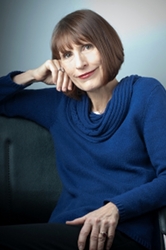
Wenonah Hauter, author, Foodopoly
Examples of such policies, she says, include irrigation subsidies with publicly funded water projects, the enactment of the Cuban sugar tariff resulting in high fructose corn syrup replacing sugar in the top spot, and poor federal oversight that keeps the United States Department of Agriculture (USDA) from testing meat for contaminants.
The author points to USDA data indicating that only 5 percent of farms supplying local markets are large but that those farms were the source of 93 percent of the so called local foods in supermarkets and restaurants; while 81 percent of farms selling local food are small with sales of $50,000 or less, and 14 percent of farms selling local foods are medium with sales between $50,000 and $250,000. The small and medium farms accounted for three quarters of direct to consumers foods, and 7 percent of the local foods in supermarkets and restaurants.
She believes the local food movement is insufficient to solve the problems our country faces. Instead, she proposes that drastic political measures are required to reform the broken system. She was too busy to respond to questions for this article or accept an invitation for a podcast interview, according to a spokesperson. To a question about the impact the book published in 2012 has had so far the spokesperson replied: “As Wenonah travels across the country she has met with hundreds of people who thank her for speaking truth to power. They tell her that Foodopoly has inspired them to do the same. This is the first step towards growing leaders who can grow the movement for real change.”
Hauter is executive director of Food & Water Watch. She has worked at the national level on food, water, energy and environmental issues. She owns an organic farm that provides vegetables to five hundred families in the area as part of the Community Supported Agriculture (CSA) program. In 2008, she wrote Zapped! Irradiation and the Death of Food with Mark Worth and in that same year contributed to the collection of essays Water Consciousness.
In response to a question about the political power changes she talks about in the book, the spokesperson replied: “The political shifts discussed in the book didn’t happen overnight, so we can’t expect them to shift back overnight either. Fundamentally fixing the food system is going to take some time — a decade or more to begin to see real change. As Wenonah says in the book, there are no shortcuts to building the long-term political power needed to reclaim our food system, our democracy and our commons. That said, people are becoming more alert and tuned into the corporate abuses of our food system. The fact that activists were able to pressure more than 5 percent of grocery stores, including Whole Foods and Trader Joe’s, to agree not to sell GE salmon, is one recent indicator that more and more people are paying attention and mobilizing. However, we need more of those people to engage in the political system and hold their elected officials accountable.”
Comments:
Filed Under: Books
Posted by Elena del Valle on April 29, 2013

Suk Park, cofounder, Dramafever Corp.
Photo: Dramafever Corp.
A podcast interview with Suk Park, cofounder, Dramafever Corp. is available in the Podcast Section of Hispanic Marketing & Public Relations, HispanicMPR.com. During the podcast, he discusses his company with Elena del Valle, host of the HispanicMPR.com podcast.
Suk oversees licensing and revenue-generating activities, including advertising sales and redistribution partnerships to multiple top-tier platforms at his company. He has 15 years of international business experience, striking joint ventures and licensing partnerships in 24 countries throughout Asia, Latin America and Europe. Prior to DramaFever, Suk led the international division of Ziff Davis Media, and was director of International Business Development at Citadon.
Born in Korea and raised in Spain, he began his career at Salomon Smith Barney after earning a Masters of Business Administration from New York’s Columbia Business School and graduating cum laude from the University of Rochester in New York. He lives in New York with his wife Boram and his daughter.
To listen to the interview, scroll down until you see “Podcast” on the right hand side, then select “HMPR Suk Park” click on the play button below or download the MP3 file to your iPod or MP3 player to listen on the go, in your car or at home. To download it, click on “Get HMPR Podcast” on the right side of the homepage. The podcast will remain listed in the April 2013 section of the podcast archive.
Posted by Elena del Valle on April 25, 2013
Information provided by Event and Program Partner
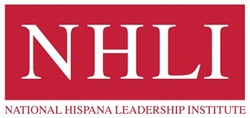
The National Hispana Leadership Institute’s Latinas Learning to Lead Program
The Latinas Learning to Lead program targets college-enrolled, 18-24 year old Latinas that are seeking to impact their community. The program promotes and fosters the career and educational development of young Latina leaders through training, mentoring opportunities, and access to national networks.
The LLL program annually selects about 22 fellows. Session topics include effective communication and presentation skills, advocacy training, public policy issues affecting the Latino community and other professional and leadership development topics, such as financial literacy and career opportunities.
Application and program deadlines are as follows:
-
Wednesday, May 15, 2013 at 5 pm EST: Application deadline
- Mid May: Application notifications
- July 21-27th, 2013: Leadership Training in Washington, DC
- July 28th and beyond: Participate in Mentorship Programs
-
July 2013-2013 Fall semester/quarter: Leadership projects implemented in communities
For more program and application information visit www.nhli.org or contact NHLI at Programs@nhli.org.
Posted by Elena del Valle on April 24, 2013
By Viola Sanchez
Southeast Division, Vice President
PS Business Parks
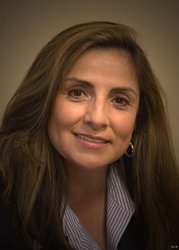
Viola Sanchez, vice president, Southeast Division, PS Business Parks
Photo: PS Business Parks
I am a woman. This is not a new found realization or one that should come across as a monumental statement. However, in my line of work, commercial real estate, it still remains a pejorative point of differentiation, albeit less so in recent years. Nevertheless, it is time we move past false rhetoric and forge a future of equality based on factual data and a little “women’s intuition.”
Commercial real estate and its myriad of sectors and nuances make for a fascinating field. Recently women have begun to enter the industry in earnest and currently account for 43 percent of the workforce. However, many have yet to reach the higher ranks of leadership.
Click to read the entire article Why Women Should Dominate Commercial Real Estate
Posted by Elena del Valle on April 22, 2013
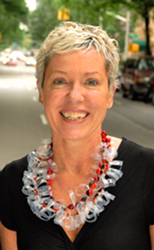
Tatiana Pages, CEO, Greencard Creative
Photo: Greencard Creative
A podcast interview with Tatiana Pages, chief executive officer, Greencard Creative is available in the Podcast Section of Hispanic Marketing & Public Relations, HispanicMPR.com. During the podcast, she discusses a contemporary approach to the American Latino market with Elena del Valle, host of the HispanicMPR.com podcast.
Tatiana is also chief creative officer of Greencard Creative, a New York City branding, strategy and design firm. She combines her love of design, art, branding, and social responsibility and sustainability to create targeted campaigns and brand insights for companies in the food and beverage, beauty, science, fashion, social, cultural and personal care industries.
In 2007 she coined the term American Latino market to redefine Hispanic stereotypes and uncover their rapidly changing behaviors and rituals. Through in-depth research, she has examined human behavior and key consumer insights to help build global brand movements. She has worked with Smirnoff Ice, Pepsico/Ocean Spray, Heineken, Diageo, Petit Nectars, Gallo Winery, Johnson & Johnson, Bayer, Frito Lay, Campbell’s, and the country of Ecuador.
To listen to the interview, scroll down until you see “Podcast” on the right hand side, then select “HMPR Tatiana Pages” click on the play button below or download the MP3 file to your iPod or MP3 player to listen on the go, in your car or at home. To download it, click on the arrow of the recording you wish to copy and save it to disk. The podcast will remain listed in the April 2013 section of the podcast archive.
Posted by Elena del Valle on April 19, 2013
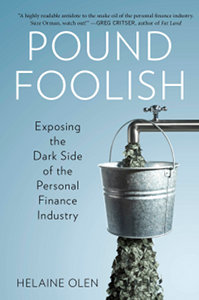
Pound Foolish book cover
Photos: Andrew Walker
In the 1950s, less than 5 percent of Americans had stock market investments. By the 1980s, that number had quadrupled to one in five Americans and by the millennium more than half of the population had ties to the stock market, according to journalist Helaine Olen.
She is convinced that a financial products and self help industry promoted a dream to Americans. It had the allure of magic, Olen says in her book Pound Foolish Exposing the Dark Side of the Personal Finance Industry (Portfolio/Penguin, $27.95), promising to make up for stagnant salaries, unequal income and dwindling financial safety nets. The sellers? People, businesses and organizations who stood to gain from the public’s buy in of the dream. The personal finance and investment industrial promised many things it couldn’t deliver, she says.
The 292-page hardcover book she began working on in 2009 was published in 2012. It is divided into nine chapters: What Hath Sylvia Wrought?, The Tao of Suze, The Latte Is a Lie, Slip Slidin’ Away, The Road to Pas Tina, I’ve Got the Horse Right Here, An Empire of Her Own, Who Wants to Be a Real Estate Millionaire?, Elmo Is B(r)ought to You By the Letter P, and We Need to Talk About Our Money.
Olen concludes that given the current economy personal financial success born of following the advice of self proclaimed self help gurus is unlikely. Financial planning can help people get out and stay out of debt, be instrumental in preparing for retirement and reaching long term goals; but no amount of financial planning can overcome a downward economy or bad circumstances, she says. What to do? She recommends being honest about our personal situation and beginning a conversation about our community’s financial situation.

Helaine Olen, author, Pound Foolish
A freelance journalist formerly in charge of the Money Makeover series at the Los Angeles Times, Olen’s work has appeared in The New York Times, The Washington Post, Slate, Salon and Forbes. She lives in New York City with her family.
Comments:
Filed Under: Books
Posted by Elena del Valle on April 15, 2013
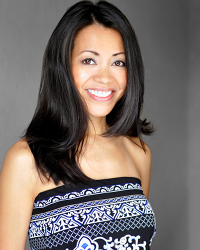
Maureen Francisco, author, It Takes Moxie
Photo: PR by the Book-Austin
A podcast interview with Maureen Francisco, author, It Takes Moxie, Off the Boat, or Out of School, to Making It Your Way in America is available in the Podcast Section of Hispanic Marketing & Public Relations, HispanicMPR.com. During the podcast, she discusses her book with Elena del Valle, host of the HispanicMPR.com podcast.
After graduating from college Maureen spent the five years rising in the ranks of the media world as a TV news reporter or weekend anchor at station affiliates around the country, ending up at a station in the top-twelve market of Seattle, Washington. She worked in sales for a while before following her next big dream: reality TV. She was the first contestant on CBS’s Power of Ten with Drew Carey, joined the reality show Solitary 3.0 and segued into modeling, acting, and writing.
She is co-owner of NW Productions, a media and production company and working on her first screenplay. She is also the co-president of the Seattle Ascend Chapter, a non-profit organization that nurtures Pan Asian leaders.
To listen to the interview, scroll down until you see “Podcast” on the right hand side, then select “HMPR Maureen Francisco” click on the play button below or download the MP3 file to your iPod or MP3 player to listen on the go, in your car or at home. To download it, click on the arrow of the recording you wish to copy and save it to disk. The podcast will remain listed in the April 2013 section of the podcast archive.





















